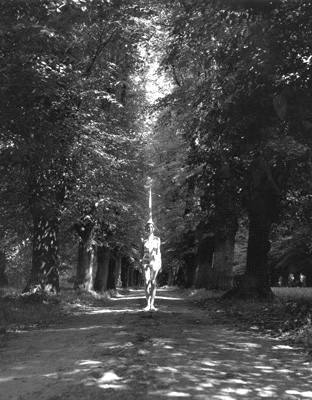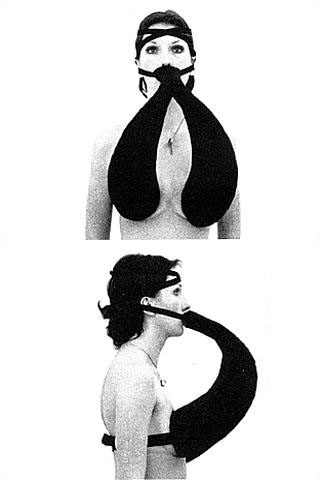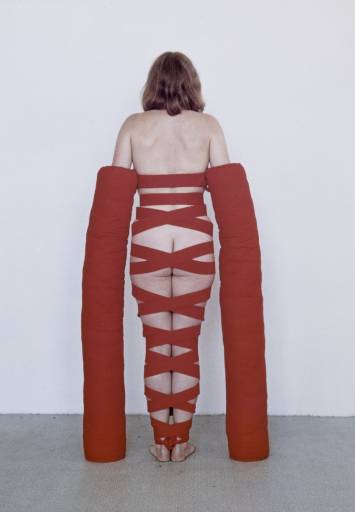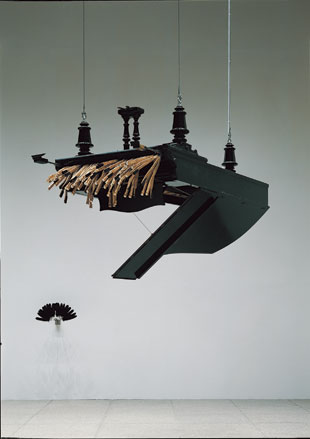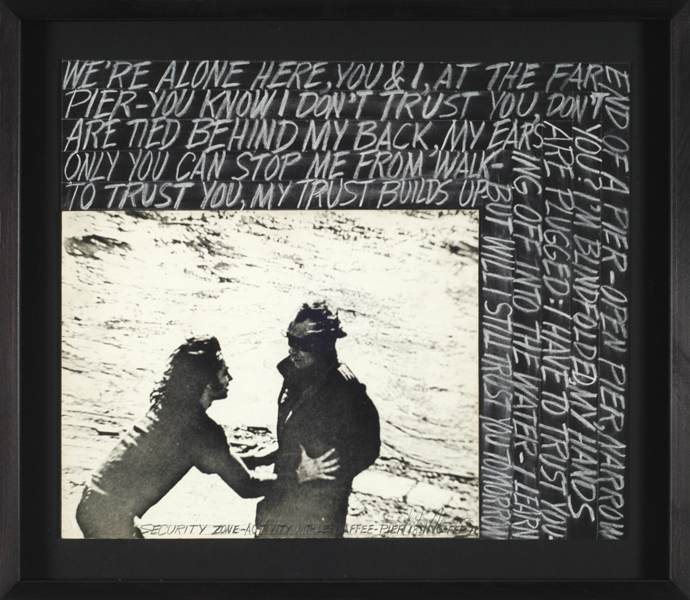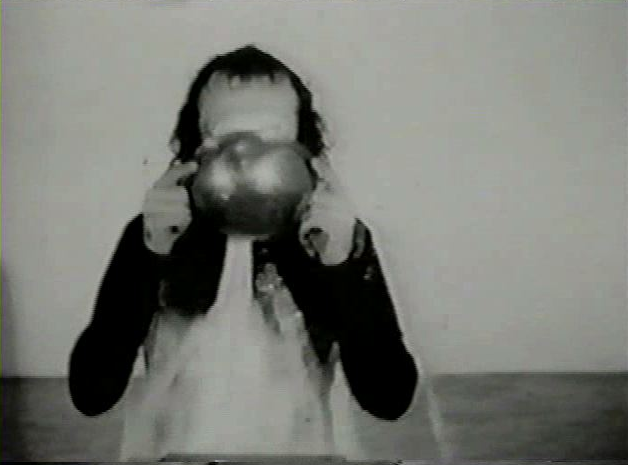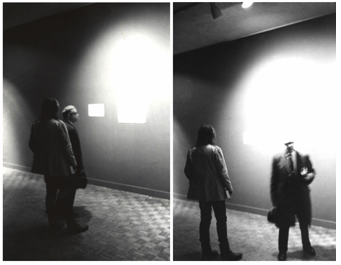Sculpture Studio Portfolio (SP10)
/Caitie Harrigan
Project 2: Kinetics and Interactivity
ARTIST RESEARCH
Rebecca Horn and Vito Acconci
Paste text and insert image(s) of project here (jpeg image files should be sized no larger than 300 pixels wide and or tall and located the in "images" folder within your site folder and then linked to display here (Insert menu > insert image command).
Note: Asterisks (*) mark works for which I was unable to find photographs.
Almost all of Rebecca Horn’s artwork deals with interactivity in various ways. The least interactive of which would be her films (for the viewer), but the performers within the films are experiencing her artwork directly, such as Unicorn in Performances II (1970), where the actress walks through nature while balancing a horn on her head. A second type of interactivity Horn explores involves the body and adding extensions or objects to the form, not chiefly for aesthetics but for sensations. These objects branch off into Horn’s creation of self-moving machines, which are more in the kinetic category of art, whose movements and appearance serve to evoke a certain reaction and response from the viewer. Finally, and perhaps the most interactive of her work, Horn creates installations that need direct participation of the viewer, often in works that are designed specifically for a certain environment.
Unicorn (1970)
Horn creates sculptures to be worn on the body in order to heighten the wearer’s senses, which can trigger an awareness to the wearer’s body overall (such as its vulnerability). For example, Measure Box* (1970) is a metal box that a person stands in the middle of with their arms to their sides, where metal rods are attached to the edges and pushed inward to touch vertical points of a persons body in four lines (front, both sides, and back). These metal points touch places such as the skull, forehead, neck, stomach, legs, arms, crotch, etc. One can assume that the person standing inside would have heightened awareness of the places each rod touches, more so than the parts it does not, and be more conscious of the amount of space his or her body takes up. Other body pieces are worn for a different type of meaning, such as in Cornucopia, Séance for Two Breasts (1970). In this piece, a two fabric cones are attached to a woman’s breasts and join together to form a mouthpiece, which is strapped to the wearer’s head. As the name implies, their shape looks like a cornucopia, which represents bounty, but the séance, an attempt to make contact with the dead, can be assumed to mean how the wearer can try to speak to the breasts, which are not alive. Whatever meaning an individual attaches to the piece, the work serves to emphasize a woman’s relationship to her breasts. A final example, Arm Extension (1970) is a piece in which the wearer’s legs are bound together, and a fabric extension is attached to the arms to make them touch the ground, like crutches. Not only is the naked wearer’s legs bound together by what is reminiscent of bandages, but the extensions serve to remind the wearer of their limbs by expanding the use of the arms and restricting the legs.
Cornucopia, Séance for Two Breasts (1970); Arm Extension (1970)
Horn’s kinetic mechanisms give the chosen objects a certain type of soul and meaning, as they move on their own in a very specific way. For example, Concert for Anarchy (1990) is a piano that is hung upside-down from the ceiling. After a certain amount of time goes by, the piano “spits out” its keys and insides, and then retracts them after a few minutes. The specific choice of an instrument, hung upside-down, and “throwing up” its music-making parts, suggests discord and cacophony, even more emphasized by using the word “anarchy” in the title. The piano seems to be revealing something about itself, ultimately representing the human that would play it, or has caused it to act that way, or its ultimate refusal to be played. Another example, Lola* (1987) consists of two red tap shoes hovering over the floor, and above it a mechanism that shoots out red paint that covers the wall below, creating a pool of red at the bottom, and sullies the shoes. Although personally I am not sure about the reference in the title, it is possible that Horn is referring to Lola Lola, a cabaret dancer in the film Der Blaue Engle. It is also feasible that Horn is referencing dancers in general, and the red paint symbolizes blood for either the pain that being a dancer requires or how a female dancer is treated, and the image of the shoes being empty denotes death of the body.
Concert for Anarchy (1990)
In perhaps the most interactive of her work, Horn creates installations specific to certain environments, and the environment becomes the meaning of the piece. For example, Horn explores and emphasizes an already existing environment, former prison and torture site Der Zwinger of Münster, Germany, that becomes the site for her work Concert in Reverse* (1987). In this piece, Horn leads the viewer into the tower with oil lamps down the path in the cellar that lead to the outer courtyard. Meanwhile, the sounds of small steel hammers rhythmically hitting the walls fills the sound of the corridor. In the overgrown courtyard is placed a glass funnel that releases a drop of water every twenty seconds that breaks the surface of a black pool almost 40 feet below it. A pair of snakes is kept in a cage in the same room. This piece, lit by moving fire light with the noise of the steel hammers, emphasizes the history of the place. The drop of water breaking the surface can be seen as a reminder of the flow of time, which going to disturb the smooth surface of the water forever. The snakes seem to represent the caged danger that had existed in the place (as a symbol for pain, death, and overall evil).
A final example of her interactive environment is an installation of a box with open doors, called The Chinese Fiancée* (1967). Once the viewer steps inside, the change of weight on the floor automatically shuts the doors all around, enveloping the person in instant darkness. After about a minute, while the viewer is adjusting to the shock, a recording of a voice speaking and giggling in Chinese is playing, meant to calm the viewer. Then suddenly, all of the doors open, and the viewer is overwhelmed by brightness. This installation serves as a force to heighten the viewer’s senses: the unexpected absence of sight may lead the participant to feel around the space to define it, and sound is intensified by the recording of a voice in a language that the audience probably does not know (the exhibit was located in New York). After the viewer is given chance to adjust, suddenly the doors open and the light overwhelms the sense of sight. Besides the sensation caused by the piece, one could even assume that Horn could be making a statement on Chinese marriage based on the title.
All of Rebecca Horn’s works function in multiple ways to create a heightened awareness of the body by attaching objects to the body, creating mechanisms that mimic the human body, and installing different environments for the body. Each work has a different theme that is expressed through its interactivity and kinetics, whether it involves human vulnerability, sensory awareness, transformation, etc.
***
Vito Acconci’s work is highly interactive, and that interactivity is often central to the piece, and helps construct its theme(s). Throughout time, Acconci’s work has transformed from film and body art towards more of a sculptural type, evolving with different messages and objectives. His earlier artwork has explored modes of self-analysis and the relationships between one’s self and others and the world. Acconci’s later works use interactivity with sculptural objects, moving towards using more and more natural mediums, to emphasize the viewer’s connection with his or her environment.
As Kate Linker skillfully articulates in her book Vito Acconci, “[Acconci] ‘stage[s]’ his self in his work, detaching and distancing himself from his being so as to secure its definition.” In addition, by inviting an audience to view his body pieces, the audience becomes a part of himself. This can be exemplified in works such as Reception Room* (1973) in which Acconci is naked, wrapped up in a sheet, and rolls to a different position periodically, exposing parts of his body. The way the work is set up is reminiscent of a doctor’s examination room. Acconci comments on this piece, “once I’ve exposed my fears and shames publicly, then I might be able to face them in private.” This performance depends on an interaction with an audience for Acconci to explore his self. In Security Zone (1971), Acconci invites an audience member to accompany him to an abandoned pier when he is blindfolded where he reveals something about himself he has never revealed before. By this act, he is building trust between himself and a stranger in order to better know himself.
Security Zone (1970)
Acconci examines his self in other ways, including works in which he puts his body under stress, such as in Adaptation Studies (1970). In Adaptation Study (Hand and Mouth)*, Acconci films himself stuffing his fist into his mouth until he starts to choke. In Adaptation Studies (Soap and Eyes), Acconci films himself hitting himself in the face with a plate of soap, and lets the soap drip from his skin. In these works, Acconci forces his body out of its comfort zone in order to connect with it physically by defining and expanding its limits. In other artworks, Acconci even aims to transform his body, such as in Conversations II* (1970). In this film, he burns the hair off of his breasts with a candle’s flame and hides his penis between his legs to try to appear as a woman. Acconci explores his self by trying to push past sexual boundaries.
Adaption Studies (Soap and Eyes) (1970)
Acconci moves from an emphasis on his self to the relationship between people and their environments. In many works, Acconci’s performances aim to intrude upon a viewer’s personal space, and to see how the person adapts to a stressful environment. In Performance Test* (1969), Acconci sat in a chair and stared at each member of the audience for fifteen minutes. In Proximity Piece (1970), he followed viewers in order to force himself into his or her personal space. Both of these works exemplify Acconci’s goal to explore human relationships with themselves and those around them by trying to break down the barriers. Acconci interacts with the audience to elicit certain reactions and aims to deconstruct boundaries set up by society and what is considered to be an acceptable action.
Proximity Piece (1970)
Acconci moves into another sphere of interactivity in his later art pieces in which he focuses on creating sculptural environments and objects, often becoming political and societal commentary. For many years, the image of a house is a motif in his work. For example, Collision House* (1981) is an aluminum house designed like a bomb shelter that alludes to the cold war. Umbrella House* (1982) is a structure created when a person cranks on a large umbrella lever. It opens to reveal a house made of fabric covered with propaganda: each room has its own national identity, with the “Coca-Cola” logo as its roof, only seen by someone standing outside. The Community House* (1981) can only be built when six people ride six different bicycles, which erects the fiberglass houses in a row. Each of these works are examples of interactive sculptures that comment on a part of society, the home sphere, that is directly affected by pressures of political and societal influence.
Finally, the most recent works of Vito Acconci involve plants and nature to construct theme. Kate Linker writes that these works “present the theme of the garden as an image of nature domesticated and appropriated – an image that conforms both to the bourgeois urge for order and to its impulse toward ownership as means of control.” For example, many of these sculptures involve combining plants and furniture, such as a tree structure with plant on top has a carved out trunk that becomes a chair in People Plant* (1986). A simpler form that could be inferred from these pieces than the one of Kate Linker is that Acconci is still commenting on how people adapt to their environment: in this case, it is by bringing parts of nature into the home sphere by adjusting nature to serve the needs of a house.
Vito Acconci uses art as a way to interact with his self, the people around him, and his environment. Rarely do his works aim for an aesthetic appeal, or even stay within a person’s comfort zone, including his own. Instead, Acconci’s goals are about defining and exploring connections: between a man and his body, a person to another, or a human to its space. Art is merely his instrument.
References:
Celant, Germano and Nancy Spector, Guiliana Bruno, Katharina Schmidt. Rebecca Horn. New York: The Solomon R. Guggenheim Foundation, 1995.
Liddell, C.B. “Rebecca Horn,” on Metropolis.co.jp (Accessed February 20 2010), http://metropolis.co.jp/arts/art-reviews/rebecca-horn/.
Linker, Kate. Vito Acconci. New York: Rizzoli International Publications, Inc, 1994.
“Vito Acconci,” on Electronic Arts Intermix. (Accessed February 21 2010), http://www.eai.org/eai/artistBio.htm?id=289.“Rebecca Horn Biography,” on Rebecca Horn Website (Accessed February 20 2010), http://www.rebecca-horn.de/pages/biography.html.
Saltz, Jerry. “Body Heat: Vito de Milo,” on The Village Art Voice. (Accessed February 21 2010), http://www.villagevoice.com/2004-04-20/art/body-heat/
Ward, Frazer, Mark C. Taylor, and Jennifer Bloomer. Vito Acconci. London and New York: Phaidon Press Inc, 2002.
Winterston, Jeannette. “The Bionic Woman,” on Guardian.co.uk (Accessed February 20 2010), http://www.guardian.co.uk/artanddesign/2005/may/23/art.
Back to Index
This page was last updated:
February 22, 2010 12:52 PM
